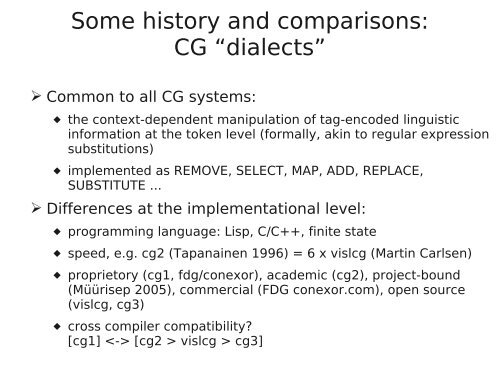On how to write rules in Constraint Grammar (CG-3) - VISL
On how to write rules in Constraint Grammar (CG-3) - VISL
On how to write rules in Constraint Grammar (CG-3) - VISL
Create successful ePaper yourself
Turn your PDF publications into a flip-book with our unique Google optimized e-Paper software.
Some his<strong>to</strong>ry and comparisons:<br />
<strong>CG</strong> “dialects”<br />
➢ Common <strong>to</strong> all <strong>CG</strong> systems:<br />
the context-dependent manipulation of tag-encoded l<strong>in</strong>guistic<br />
<strong>in</strong>formation at the <strong>to</strong>ken level (formally, ak<strong>in</strong> <strong>to</strong> regular expression<br />
substitutions)<br />
implemented as REMOVE, SELECT, MAP, ADD, REPLACE,<br />
SUBSTITUTE ...<br />
➢ Differences at the implementational level:<br />
programm<strong>in</strong>g language: Lisp, C/C++, f<strong>in</strong>ite state<br />
speed, e.g. cg2 (Tapana<strong>in</strong>en 1996) = 6 x vislcg (Mart<strong>in</strong> Carlsen)<br />
proprie<strong>to</strong>ry (cg1, fdg/conexor), academic (cg2), project-bound<br />
(Müürisep 2005), commercial (FDG conexor.com), open source<br />
(vislcg, cg3)<br />
cross compiler compatibility?<br />
[cg1] [cg2 > vislcg > cg3]
















